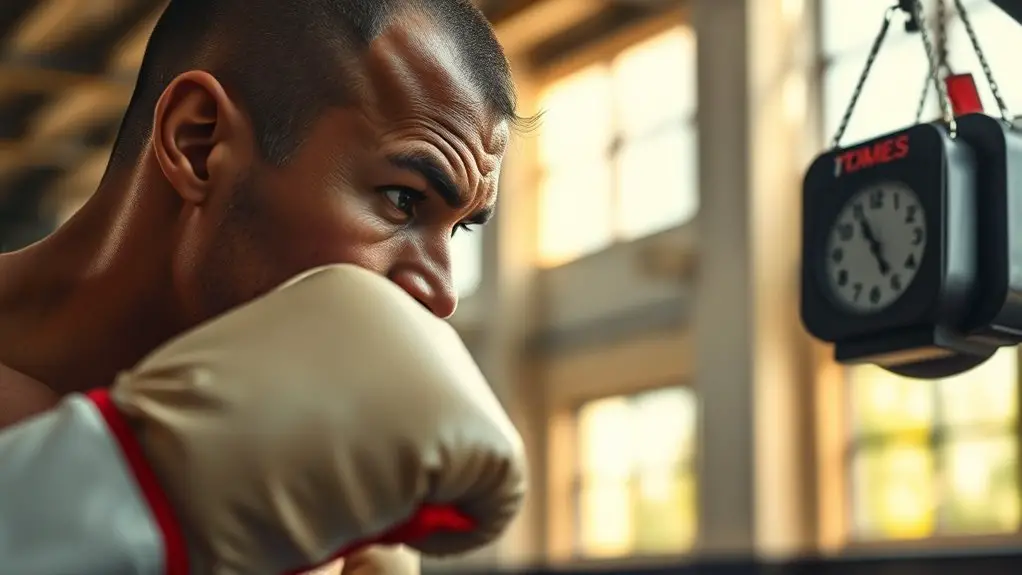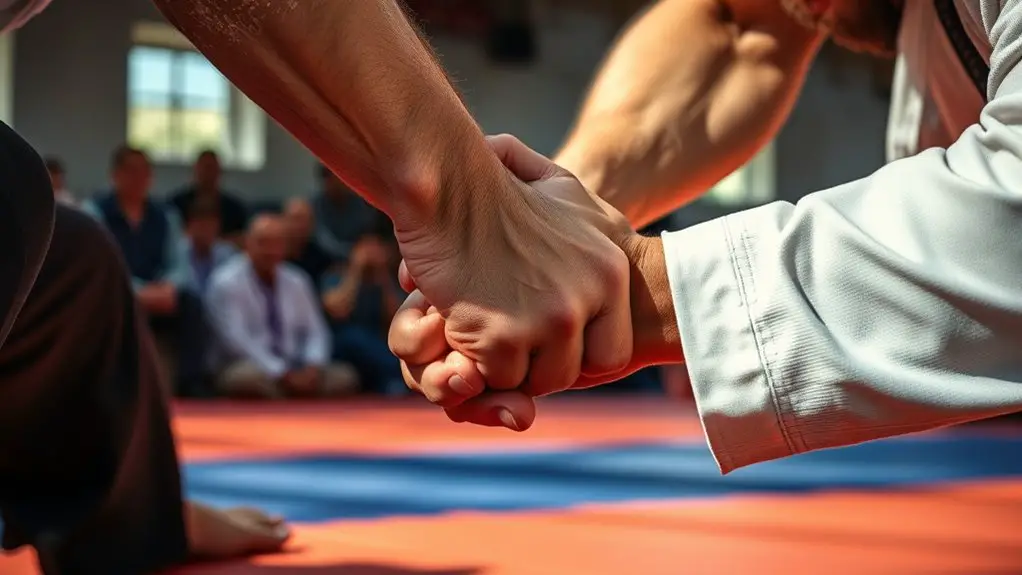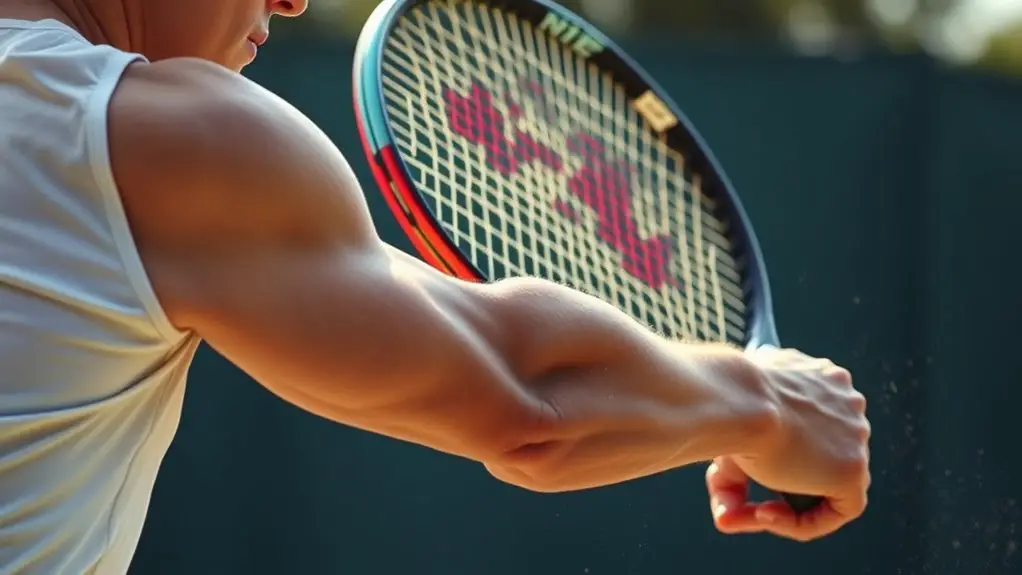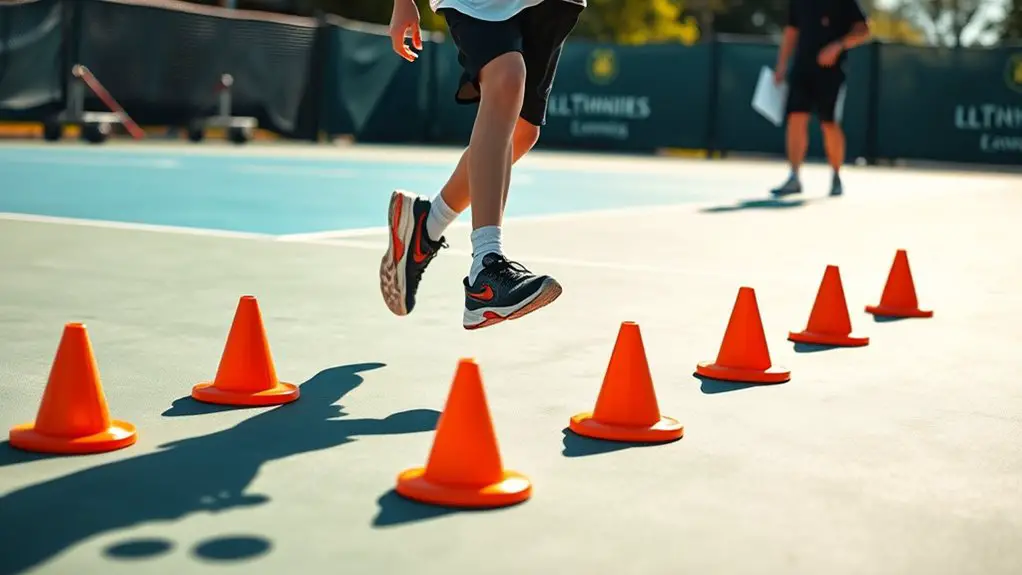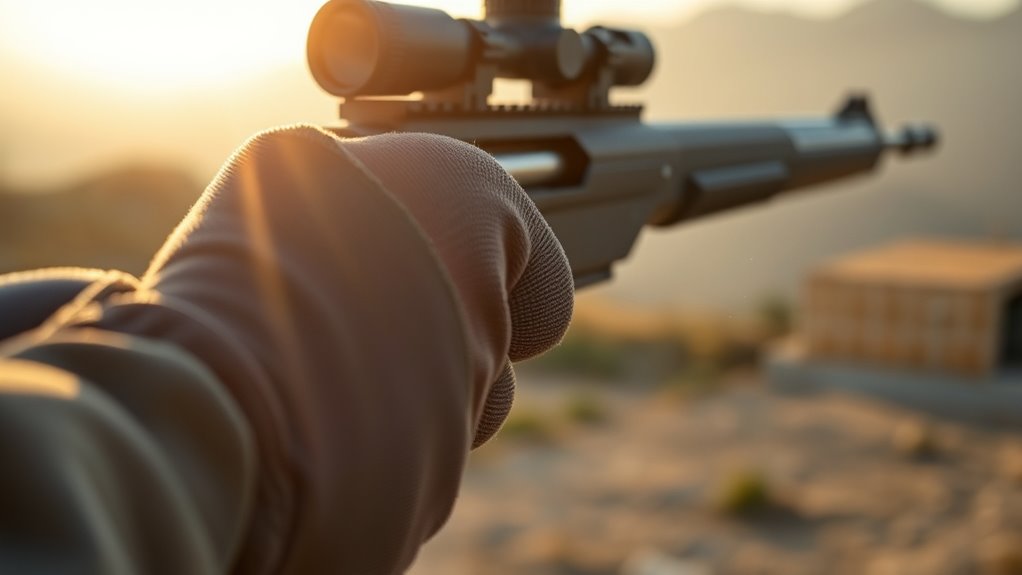To improve your hand speed and reaction time in boxing, focus on drills like shadow boxing, speed bags, and reaction balls. Work on your wrist flexibility and grip strength for quicker punches. Incorporate partner drills to simulate real fight scenarios and enhance reflexes. Don't forget the importance of strength training and conditioning for overall speed development. Also, proper nutrition and recovery play a crucial role in your performance. Keep going to discover more effective techniques and strategies!
The Importance of Hand Speed and Reaction Time in Boxing
When you step into the ring, you quickly realize that hand speed and reaction time are essential for success. In boxing, every millisecond counts; a split-second delay could mean the difference between landing a knockout punch or getting caught off guard. You've got to be quick and agile, constantly anticipating your opponent's moves. Hand speed allows you to throw punches with precision and power, keeping your opponent on their toes. The faster your hands move, the more opportunities you create to score.
But it's not just about throwing punches; reaction time is equally important. You need to respond instantly to your opponent's actions, whether it's dodging a jab or countering an attack. By honing both your hand speed and reaction time, you gain the freedom to control the fight, making you a more formidable opponent. This isn't just about technique; it's about embracing the thrill of competition and the pursuit of excellence. Incorporating reaction time drills into your training regimen can further enhance your performance and responsiveness in the ring.
Basic Techniques to Enhance Hand Speed
To boost your hand speed, incorporating specific techniques into your training routine can make a significant difference. Start by focusing on hand positioning; keeping your hands up and ready to strike allows for quicker reactions. Practice shadowboxing while emphasizing proper alignment, ensuring your fists are always in the right spot for rapid delivery.
Next, work on wrist flexibility. Flexible wrists enable you to snap punches more quickly, increasing your overall speed. Stretch your wrists daily and include exercises like wrist curls to build strength.
You can also use resistance bands to enhance muscle response, allowing for faster movements. Remember, it's all about coordination; the more fluidly your hands move, the quicker your punches will land. Additionally, improving grip strength can further enhance your overall performance in striking sports by increasing stability and coordination.
Incorporate these techniques into your routine, and you'll find your hand speed improving, giving you the freedom to release powerful strikes in the ring.
Drills for Improving Reaction Time
To sharpen your reaction time, you can incorporate shadow boxing techniques and reaction ball drills into your training routine. These exercises not only enhance your speed but also improve your overall agility in the ring. Additionally, practicing agility drills can further develop your foot speed and coordination, which are essential for effective performance in boxing. Let's explore how these drills can make a difference in your performance.
Shadow Boxing Techniques
Shadow boxing is a dynamic way to sharpen your reaction time and hand speed, allowing you to visualize your opponent while perfecting your techniques. One of the great shadow boxing benefits is that it lets you experiment with different combinations and movements without any restrictions. Try various shadow boxing variations, like using footwork to evade imaginary punches or incorporating feints to throw off your "opponent." Focus on quick, explosive movements to enhance your hand speed, and pay attention to your rhythm to improve reaction time. You can even set a timer to simulate real fight conditions, challenging yourself to react faster. Embrace the freedom of movement and creativity in your training, and watch your skills soar!
Reaction Ball Drills
While many drills focus on strength and technique, incorporating reaction ball drills can greatly enhance your reaction time in the ring. These drills utilize reaction ball techniques that improve your hand-eye coordination and overall agility. By tossing the ball against a wall or to a partner, you'll sharpen your reflexes as it rebounds unpredictably. This unpredictability forces you to react quickly, promoting coordination enhancement that's essential for boxing success. Mix it up by varying the distance and angle of your throws to challenge yourself further. You'll find that these drills not only boost your reaction time but also add a fun element to your training. Embrace this freedom in your workouts, and watch your performance soar in the ring!
Shadow Boxing: A Tool for Speed and Agility
An essential part of any boxer's training routine, shadow boxing offers a dynamic way to enhance both speed and agility in the ring. By practicing your footwork, movement, and combinations without a partner, you can develop muscle memory and improve your overall technique. The shadow boxing benefits are immense; it allows you to focus on timing and precision, ultimately sharpening your reflexes.
However, be mindful of common shadow boxing mistakes. Many fighters neglect their stance or fail to visualize an opponent, which can lead to ineffective training. To maximize your practice, visualize a real fight scenario, and push yourself to maintain high intensity. Additionally, incorporating visualization techniques into your shadow boxing can further enhance your concentration and performance.
Incorporate this tool into your routine regularly, and you'll notice an increase in your hand speed and reaction time. Embrace the freedom that comes with shadow boxing, and watch your skills soar as you become a more agile boxer.
Incorporating Speed Bags Into Your Training Routine
Incorporating speed bags into your training routine can greatly enhance your hand speed and reaction time. By mastering specific techniques and determining how often and how long to work with the bag, you'll see improvements in your overall performance. Additionally, focusing on timing and speed will further refine your ability to deliver quick and effective punches. Let's explore the best practices to make the most of this valuable training tool.
Speed Bag Techniques
Speed bags are a fantastic tool to sharpen your hand speed and reaction time in boxing. To get the most out of your training, focus on these speed bag fundamentals and explore various speed bag variations:
- Basic Punching: Start with straight punches to develop rhythm and timing.
- Alternating Hands: Switch between your left and right hands to improve coordination.
- Combination Drills: Mix jabs, crosses, and hooks for a dynamic workout.
- Footwork Integration: Incorporate movement while hitting the bag to enhance your overall agility.
Frequency and Duration
To effectively improve your hand speed and reaction time, it's essential to establish a consistent training routine with the speed bag. Aim for a training frequency of at least three to four times a week, allowing your body to adapt and grow stronger. Each session should ideally last between 15 to 30 minutes, following duration guidelines that keep you engaged without burning out. Focus on quality over quantity; it's better to have shorter, intense sessions than longer, ineffective ones. Incorporate varied drills to challenge yourself and keep things fresh. By sticking to this approach, you'll enhance your speed and reaction time while enjoying the freedom of your training journey. Embrace the process, and watch your skills soar!
Partner Drills for Real-Time Reflex Training
Partner drills are an effective way to sharpen your reflexes and hand speed in boxing. Engaging in real-time reflex challenges with a partner helps you react quickly while simulating a fight environment. Here are some drills to take into account:
- Partner Exchanges: Take turns throwing punches at each other while practicing head movement and dodging.
- Target Practice: Use focus mitts and aim for specific targets, enhancing your accuracy and speed.
- Reaction Sparring: Light sparring where you focus solely on reacting to your partner's movements without planning your own attacks.
- Feints and Counters: One partner feints an attack while the other practices countering, helping you anticipate and respond quickly.
Incorporating these drills can also help you embrace a growth mindset, which encourages learning from mistakes and seeking feedback.
The Role of Strength and Conditioning in Speed Development
A solid strength and conditioning program is essential for enhancing your hand speed and reaction time in boxing. By incorporating strength training, you'll build the muscle endurance needed to maintain your speed throughout the fight. Conditioning exercises improve your cardiovascular fitness, allowing for quicker recovery between rounds.
Agility drills develop your footwork and help you change direction rapidly, which is fundamental in the ring. Focus on explosive movements, like plyometrics, to translate your strength into speed. Plyometric training enhances coordination and improves neuromuscular control, making you more effective in the ring. Core strength is indispensable, as a strong core stabilizes your body during punches, enabling more powerful strikes. Don't overlook flexibility training; it enhances your range of motion and reduces injury risk, keeping you agile.
Nutrition and Recovery for Optimal Performance
Strength and conditioning can only take you so far without proper nutrition and recovery strategies. To really reveal your potential in the ring, focus on these key elements:
- Meal Timing: Fuel your body with the right nutrients pre- and post-workout. Eating a balanced meal about 1-2 hours before training can keep your energy up, while a recovery meal afterward helps rebuild muscle.
- Hydration Strategies: Stay hydrated throughout the day, not just during workouts. Dehydration can slow you down, so drink water consistently and consider electrolyte drinks for intense sessions. Proper hydration is essential for optimal performance and can help you avoid fatigue and cramps.
- Quality Sleep: Prioritize restorative sleep to enhance recovery and mental sharpness.
- Active Recovery: Incorporate low-intensity workouts or stretching on rest days to promote blood flow and muscle healing.
Frequently Asked Questions
How Does Age Affect Hand Speed and Reaction Time?
They say, "youth is wasted on the young," and when it comes to hand speed and reaction time, that's often true. As you age, you might notice a decline in these skills, often because younger athletes possess a youth advantage. However, with the right training techniques, you can maintain and even improve your speed and reaction time. Embracing freedom in your training can help counteract age-related decline, keeping you sharp and agile.
Can Mental Exercises Improve Boxing Reaction Time?
Absolutely, mental exercises can boost your reaction time. By incorporating visualization techniques, you can mentally rehearse scenarios, helping your brain process information faster. Cognitive drills, like reaction time games or pattern recognition tasks, sharpen your reflexes. The freedom to explore these exercises allows you to enhance your skills without physical strain. So, embrace these mental workouts, and you'll notice improvements in how quickly you respond in the ring.
What Role Does Sleep Play in Hand Speed?
You might think hand speed is all about training, but sleep quality plays an essential role too. When you're well-rested, your body recovers, allowing those recovery techniques to enhance your reflexes. A lack of sleep can dull your senses, leaving you sluggish and unresponsive. So, embrace the freedom of restful nights; they're just as important as your workouts. After all, a sharp mind and body can elevate your performance to new heights.
Are There Specific Diets That Enhance Reaction Time?
Yes, certain diets can enhance your reaction time. Focusing on nutrition timing is key; eating the right nutrients before and after workouts can fuel your performance. Incorporate complex carbs and lean proteins for sustained energy. Staying mindful of your hydration levels is equally important; dehydration can slow you down. So, drink plenty of water throughout the day. With the right diet, you'll feel more energized and agile, giving you that freedom to perform at your best.
How Can I Prevent Injuries While Training for Speed?
So, you wanna train like a superhero without the pesky injuries, huh? First, embrace those warm-up routines—think of them as your magical shield! They're essential for injury prevention, giving your muscles and joints a chance to wake up and stretch. Don't skip them! Also, listen to your body; if it's screaming, take a break. Remember, freedom to train without injury is way better than being sidelined with a sprain!
